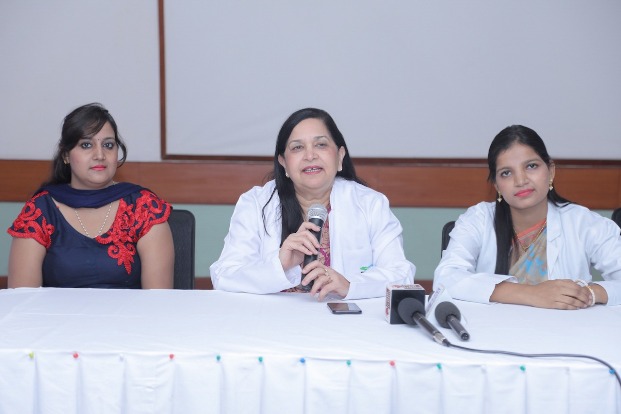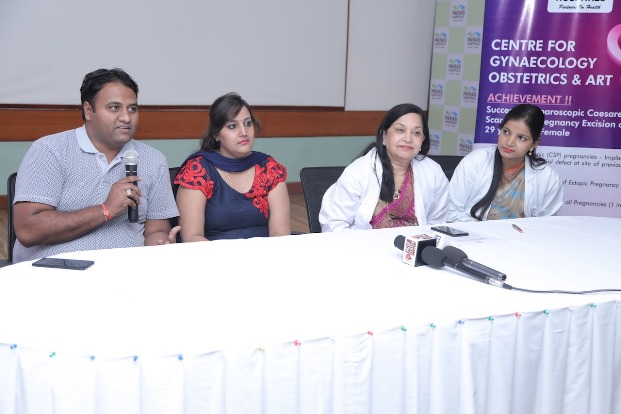Apr 25, 2022
Paras Hospital Conducts Rare and Life-Threatening Surgery to Save Mother

- Suman (29) was suffering from a rare type of caesarean scar ectopic pregnancy where the fertilized egg implants in the wall of the uterus over the previous scar.
- The incidence of such cases is 1 in 1800 to 2500 pregnancies, and such cases present severe and life-threatening conditions.
- ( Prof.) Alka Kriplani, Ex- Prof, AIIMS, Director and Head, Centre for Gynaecology, Obstetrics & ART, Padam Shri & B C Roy Awardee and team conducted a highly complicated laparoscopic procedure to save the patient.
Gurgaon, 09thMarch 2018: Suman (29) was 12 weeks pregnant and had 2 babies born with Cesarean section. She developed bleeding from early pregnancy and at that time she was in china and ultrasound was done but could not make a proper diagnosis and then she came to India where D & C was done but she continued bleeding and again D & C was done and bleeding increased.

Ultrasound was again done and a firm diagnosis of scar ectopic was made and she was referred to Paras Hospital to consult Dr. ( Prof.) Alka Kriplani, Ex- Prof, AIIMS, Director and Head, Centre for Gynaecology, Obstetrics & ART along with team and her associate Dr. Kusum Bhardwaj, Consultant – Obstetrics & Gynaecology where she and her team decided to manage this case via Minimal invasive laparoscopic approach where surgery was done without any blood transfusion and patient was discharged the very next day.
“This is an extremely rare and complicated type of pregnancy with catastrophic complications. Scar ectopic pregnancy cases usually happen after cesarean section, with a 0.15% rate in previous cesarean section women and 6.1% of all ectopic pregnancies. In case of Suman, we went for the latest laparoscopic management, which is a surgical procedure conducted through a small incision with the aid of camera. At first, a vascular mass of 5 by 5 cm was found in the left area of uterine scar extending to the board ligament encasing left uterine artery and left ureter. The vascularity of mass was cut by dissection of vasculature. The arteries of uterus were ligated at their origins. Thereafter, bladder was pushed down by a sharp dissection. Mass was excised and uterine scar was repaired in two layers. As a result, hemostasis was achieved which stopped the bleeding.”

The incidence of caesarean scar ectopic pregnancy is 1 in 1800 to 2500 pregnancies, and such cases present severe and life-threatening conditions. The condition was first described in 1978 and until 2001 only 19 cases were reported. However, with growing number of cesarean section cases, till 2011, 85 more cases have surfaced.
“The rise in incidence of such cases is recent. The global average caesarean section rate has increased by 12.4% between 1990 and 2014. As per latest the National Family Health Survey reports, average caesarean section rate in India is 17.2% (5.8% to 58%). Therefore, there is a significant rise in the risk of developing caesarean scar ectopic pregnancy. It is important to focus on early diagnosis with transvaginal ultrasound, as it can help in preventing uterine rupture and hemorrhage. In the case of Suman, timely intervention made it possible to save the life, says Dr. ( Prof.) Alka Kriplani, Ex- Prof, AIIMS, Director and Head, Centre for Gynaecology, Obstetrics & ART.
Laparoscopy not only helped in the early correct diagnoses of such cases but also in management with minimally invasive approach where 3-4 button holes are made on the belly and patient doesn’t get a big scar. Preservation of the uterus could be done and no blood transfusion was given. Suman has been discharged from hospital the very next day and is doing good. The patient and the family are thankful to the doctor for saving herlife
Approach of laparoscopy helps in precise tissue cutting and provides best results in terms of repair and future fertility and at the same time giving benefits of button hole surgery. Now she can undergo for future pregnancy safely.

